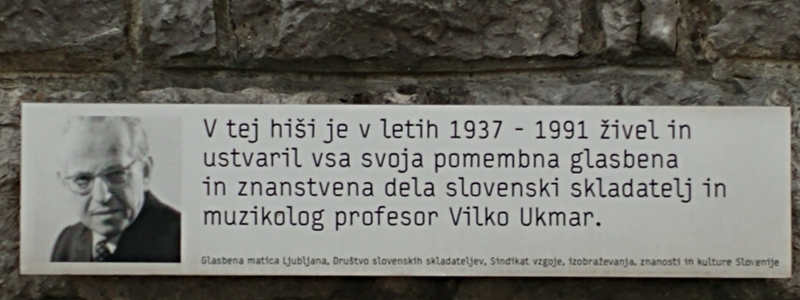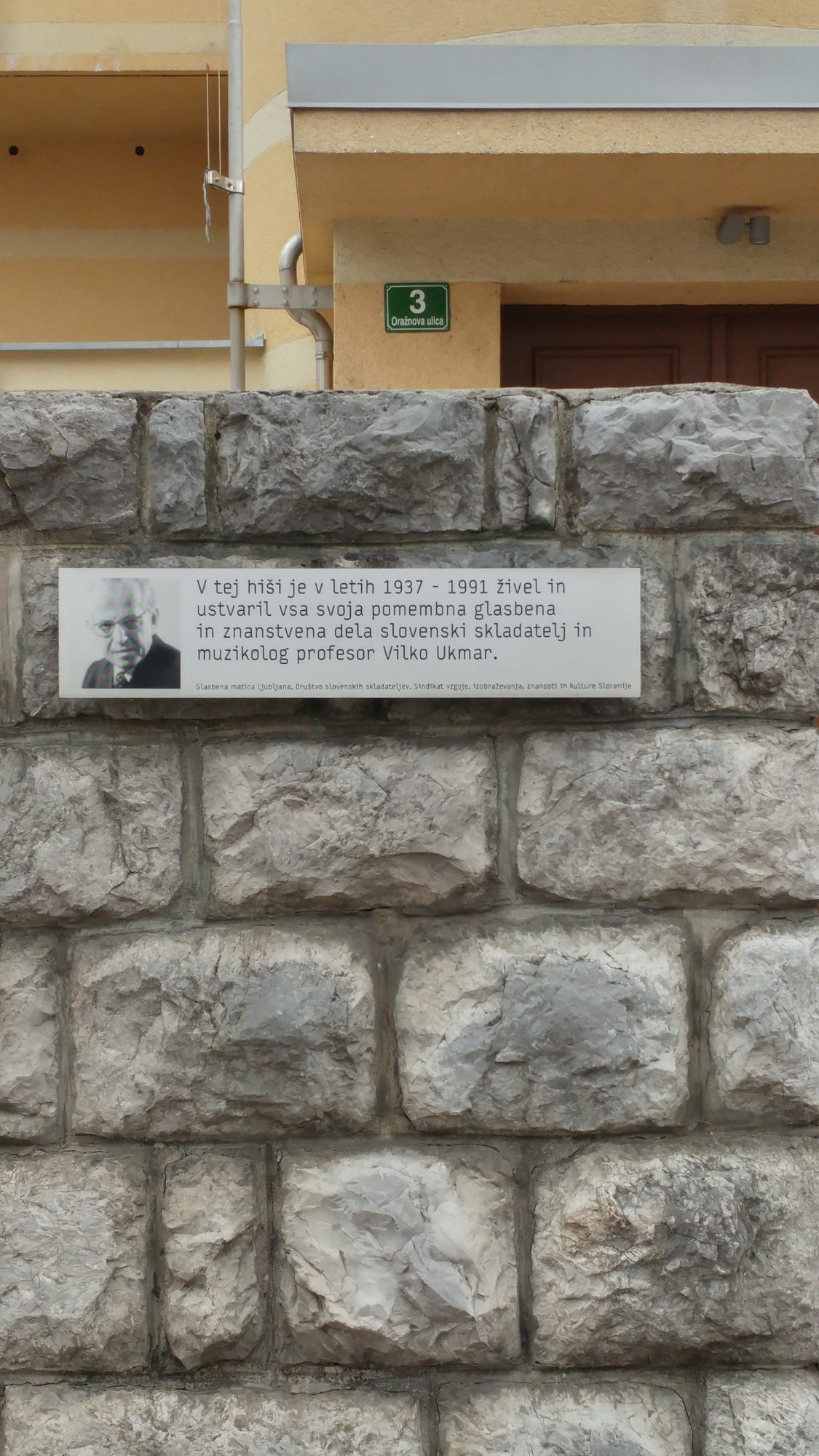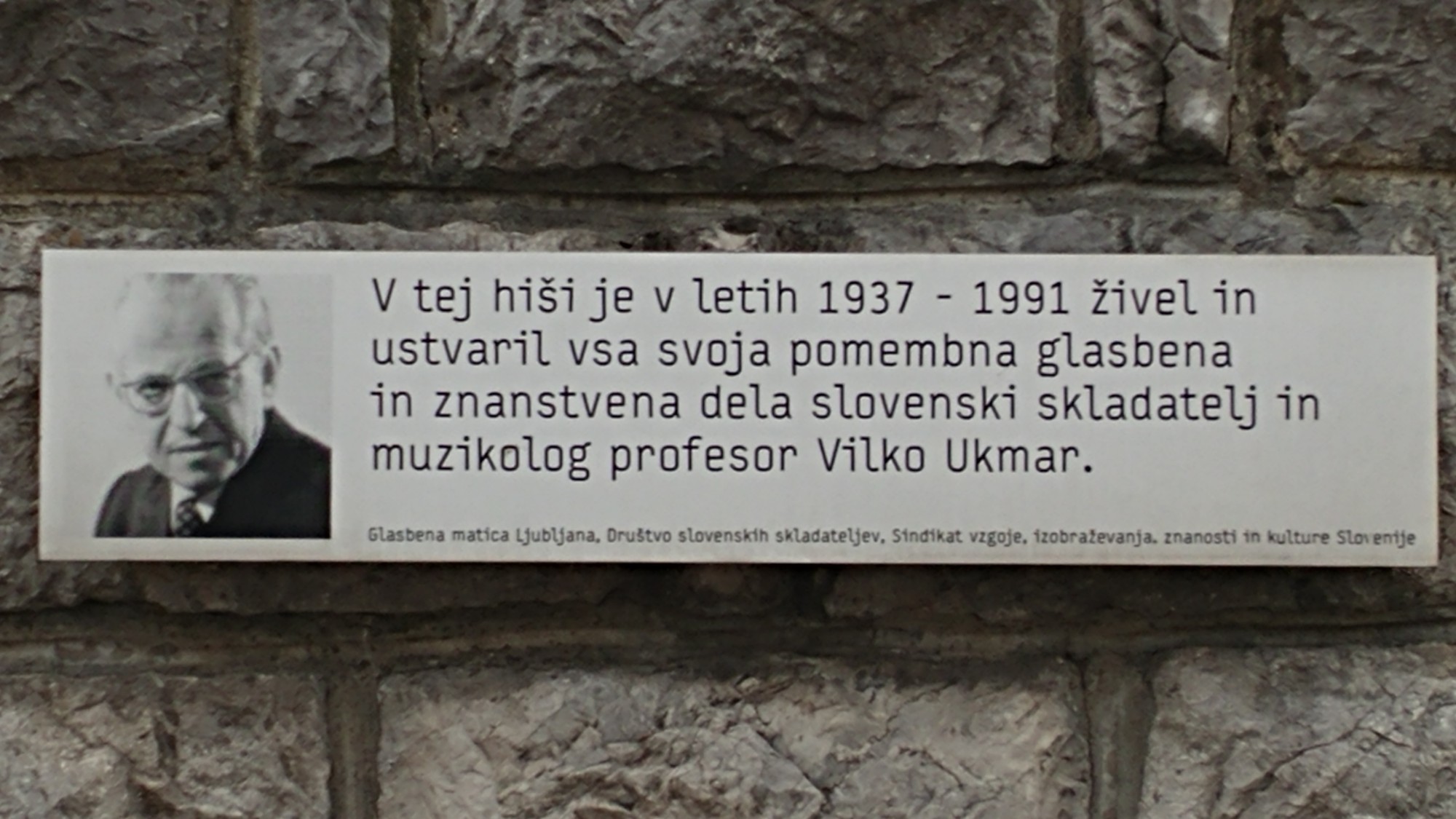In 2005, on the centennial of his birth, a memorial plaque was attached to the façade of the house in which composer and musicologist Vilko Ukmar worked for a number of years. The memorial was put up by the Glasbena matica Music Society, the Society of Slovenian Composers, the Academy of Music in Ljubljana and the Education Trade Union. The inscription reads: “Between 1937–1991, Slovenian composer and musicologist, Professor Vilko Ukmar, lived and created all his important music and scholarly works in this house.”
Vilko Ukmar
Vilko Ukmar (1905–1991) divided his life between music and broader scholarly reflection on art. In his compositions, influences of romanticism and impressionism (a flair for harmonic colour and orchestration) are juxtaposed against a modernist tendency towards sharper sonority, although never for the sake of innovation. Ukmar was also a prominent music educator, historian and aesthete.
He completed primary education in his birthplace, Postojna, and entered the Diocesan Classical Gymnasium in Šentvid, Ljubljana, and then enrolled in the Ljubljana Faculty of Law. He concurrently studied composition and cello at the Ljubljana Conservatory of Music. As a student, he was already writing lieder, piano compositions, choral and theatre music. Graduating in law, he entered the New Vienna Conservatory. He studied composition and counterpoint with Ivan Langstroth, and privately with Walter Bricht. Several months before returning to Ljubljana, he learnt of the death of his friend, art historian, musicologist and ethnologist Stanko Vurnik. Ukmar succeeded Vurnik in his pursuit as music critic and expert on aesthetics and the history of music. After pursuing further studies at the Zagreb Academy of Music, he took up a teaching post at Ljubljana Conservatory of Music, and in 1939 was appointed Director of the Ljubljana Opera. After WWII, he taught at the Academy of Music and gradually qualified as a full professor. Among other things, he taught music history and aesthetics.
Towards the end of his studies, he scored works containing romantic elements, which already reflected hints of expressionism, e.g. the Sonata for piano (1932). In works composed after WWII, he returned to neoromantic and impressionistic styles. Simfonični poem št. 1 in three movements (Symphonic Poem No. 1, 1957) develops by alternating short mellifluous motifs and quieter quiescent harmonic bases with fast-moving lines of woodwinds and richly scored crescendos; the cycle’s tension is not resolved until seconds before the conclusion, and abruptly so. In the ballet and suite Lepa Vida (Lovely Vida, 1955, 1974) Ukmar provides no appeasement; the tension in the call of the native bells, represented by harp and tubular bells, finds no final release, not even when the ringing ends, being followed by a series of short, richly scored phrases. The composer’s musical flow is likewise unpredictable. Imaginacije for violin and piano (Imaginations, 1956) comprise diverse clusters of chords and added tones, radiating a flair for harmonic colouring that blurs the paths to concluding musical thoughts. The chamber output, moreover, includes compositions Ekspresije za klavir (Expressions for Piano, 1962), a collection of lieder Astralna erotika (Astral Eroticism, 1968), Reminiscence for two violins (Reminiscences, 1982) and other works.
Simfonični poem št. 2 (Symphonic Poem No. 2, 1962) contains a large second movement with a pastoral flavour, imparted by quiet solos by flute, clarinet and other woodwinds. The form is still coherent, although the chords are harsher in sound, especially in the more progressive first movement, tending towards a wider tonal range, yet still not departing into serialism. The sonic boldness is also manifest in other symphonic works, e.g. Simfonija št. 3 (Symphony No.3, 1967), in which Ukmar took full advantage of the sonority of brass instruments, and Transformacije for string orchestra, harp and percussion (Transformations, 1973). Throughout that period, Ukmar also scored the cantatas Integrali (Integrals, 1972), Alarm (1977) and Starka za vasjo (Old Woman outside the Village, 1981).
Ukmar tailored his musical style according to the applicability of his means of expression, so as to most effectively guide listeners towards fully grasping the message of his composition. Such forethought is well manifested in the still popular choral settings of poems by Srečko Kosovel, Oton Župančič, France Bevk and folk songs. Ukmar never fully embraced serial composition nor did he emulate past styles. His music is expressionist in its dispersal of motifs, surging melodies and changing moods spurred by inner impulses.
Lev Fišer


